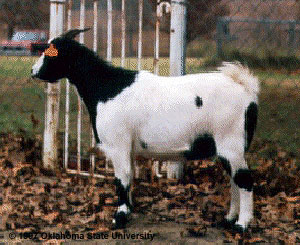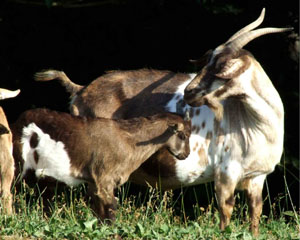Myotonic (Wooden Leg) Goats
 Myotonic goats are also called Wooden Leg goats, "stiff leg" or Tennessee fainting
goats. These are one of the few goats that are indigenous to the U.S. There are two
strains of this animal. Most of those found in Tennessee and the eastern U.S. are
smaller. Most Texas herds tend to be somewhat larger, probably due to selective breeding
for the meat market. In fact, some ranchers have renamed them Tennessee Meat Goats.
Myotonic goats are also called Wooden Leg goats, "stiff leg" or Tennessee fainting
goats. These are one of the few goats that are indigenous to the U.S. There are two
strains of this animal. Most of those found in Tennessee and the eastern U.S. are
smaller. Most Texas herds tend to be somewhat larger, probably due to selective breeding
for the meat market. In fact, some ranchers have renamed them Tennessee Meat Goats.
They also have a market as pets because they are unique. Myotonic means when they are frightened or excited they "lock up" and often fall over (faint) and lie very stiff for a few seconds. It is an over-simplification, but the chemicals which are rushed to humans' muscles and joints to prepare them for "fight or flight" are withheld in the Myotonic under exciting or frightful circumstances.
No one really knows their origin. There are two theories. One of the possibilities is that a private herd sold to a Tennessee farmer around 1880 was the beginning of the breed. A man named John Tinsley arrived in Marshall County, Tennessee, with four goats, a billy and three nannies, which he had brought from Nova Scotia. When he moved on a year later, he left his goats behind. It is believed that all the Fainting goats in the U.S. can trace their origins back to these four.
The other is that there was a spontaneous mutation of a herd in Tennessee about 1885 which resulted in the recessive gene.
 Myotonic goats which have been selected for meat production are heavy rumped, deep
chested animals. Most are black and white but multi-colors are not uncommon. They
breed seasonally, are easy kidders and have good milk production. Many breeders have
noted the breed has the capability to produce two kiddings a year. They are good mothers
so in most cases a bonding pen is not needed. Since they are not good climbers and
jumpers they are somewhat easier to keep than other goats.
Myotonic goats which have been selected for meat production are heavy rumped, deep
chested animals. Most are black and white but multi-colors are not uncommon. They
breed seasonally, are easy kidders and have good milk production. Many breeders have
noted the breed has the capability to produce two kiddings a year. They are good mothers
so in most cases a bonding pen is not needed. Since they are not good climbers and
jumpers they are somewhat easier to keep than other goats.
The American Livestock Breed Conservancy has placed this breed of goat on their "rare" list, with an estimated world population of under 10,000. They have now been discovered as excellent crossbreed stock for the Boer goat, a meat goat which was imported from South Africa. The "fainting" gene is recessive, therefore it is usually not expressed in crossbred animals.
Registries and Breed Associations
United States
American Meat Goat Association
PO Box 498
Mertzon, TX 76941
Phone: (915) 835-2605
FAX: (915) 835-2259
International Fainting Goat Association
Registrar Lottie Long
2455 Deanburg Road
Pinson, TN 38366
Lisa Edinger / Treasurer brassringfarm@gmail.com
Myotonic Goat Registry (MGR)
P.O. Box 237 Chapel Hill, TN 37034
Phone: (931) 364-7206
Email: myotonic@myotonicgoatregistry.com
References
Correspondence, Ed Jackson, Sapulpa, OK. Internet mail: tejas@ionet.net
American Breeds of Livestock Notebook. The Livestock Conservancy PO Box 477, 33 Hillsboro St, Pittsboro, NC 27312. 1989.
